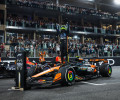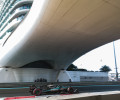FIA to implement procedural measures based on the findings of the review into incidents at the 2022 Japanese Grand Prix
Thorough review overseen by FIA Deputy President for Sport Robert Reid.
Findings based on the FIA’s critical reflection process, feedback from the GPDA and drivers including George Russell and Pierre Gasly.
A number of measures have been adopted as a result of the findings.

The findings of a far-reaching FIA review of incidents at the 2022 Japanese Grand Prix at Suzuka Circuit have determined that a number of procedural recommendations will be implemented.
The review is based on the FIA’s critical reflection process, a letter from the Grand Prix Drivers’ Association and discussions between the FIA President Mohammed Ben Sulayem and a number of drivers including George Russell, GPDA Director, and AlphaTauri’s Pierre Gasly who expressed their concerns over the on-track incidents during the severely rain-affected race at Suzuka.
From an operational standpoint, the review was originated by the FIA Remote Operations Centre (ROC) in Geneva immediately after a series of incidents on lap two of the Grand Prix. The ROC, introduced for the 2022 season, provides support on procedural, sporting and regulatory matters to Race Control during race weekends.
The review panel comprised representatives from a number of FIA departments including Race Control, ROC, Safety, Operations and Technical. The process was overseen by FIA Deputy President for Sport Robert Reid, who was in attendance in Suzuka.
The ROC has recreated a full timeline of the incidents from video and data capture.
The wet track conditions and driver visibility were taken into account by Race Control staff from Suzuka together with the ROC in reaching their conclusions. A lengthy study of video footage and Race Control telemetry and ROC data was undertaken.
Driver behaviour and the performance of circuit marshals and recovery vehicle operators was also evaluated. The conclusions of the review has led to the adoption of a number of measures for the future.
The FIA is committed to constant improvement and analysis so that situations such as that which occurred in Suzuka can be avoided or at least safely mitigated.
Race start
Although it was raining, conditions were suitable enough to start the Race from a standing start on time. All teams started on intermediate tyres following reconnaissance laps to the grid, but heavier rain around the time of the start meant that car control on intermediate tyres after the start was more challenging.
Deployment of recovery vehicles and marshals
The review concluded that all FIA race procedures were followed. After the incident involving the Ferrari of Carlos Sainz at Turn 12, the track was neutralised with the Safety Car before marshals and recovery vehicles were deployed on track.
The review noted that in such conditions, a recovery vehicle should not be deployed unless all cars are aligned behind the Safety Car. Furthermore, marshals and recovery equipment would only be deployed whilst cars are on track (Safety Car periods) when the weather conditions and location of the cars to be recovered allow for a quick and safe intervention.
Given the track conditions and the overall visibility for drivers, marshals and recovery staff at the time, initially under a Safety Car followed by a Red Flag, and as efforts were focused on safe recovery, the AlphaTauri of Pierre Gasly in the Pit Lane was not immediately detected.
Race Control do not necessarily monitor all cars that may pit during Safety Car periods as they are more concerned about any area containing an incident and neutralising the field behind the Safety Car.
After his Pit Stop, Gasly rejoined the track and drove to his Safety Car delta time in an effort to catch the pack. When he reached the incident in Turn 12 for the second time, marshals were working with a crane on track.
Even though it is common practice to deploy recovery vehicles once a race has been neutralised, the review panel discussed whether the entry of the recovery vehicle at Suzuka to retrieve the stricken Ferrari of Carlos Sainz was premature given the prevailing conditions.
The review panel acknowledged that having recovery cranes on track at Suzuka during the weather conditions is a sensitive matter in view of the tragic incidents of the past. The panel determined that in hindsight, as the weather conditions were changing, it would have been prudent to have delayed the deployment of the recovery vehicles on track.
It was acknowledged that every effort should be made to perform an efficient and safe recovery of cars. A longer recovery period, in conditions such as those which prevailed in Suzuka, may result in a race suspension.
It was also acknowledged that while the Safety Car is used to neutralise a race, the FIA has control over the cars directly behind the Safety Car, but it does not have sufficient control over the cars that are elsewhere around the track.
Drivers’ obligations
It was also acknowledged that in accordance with the applicable regulations, drivers have an obligation to limit their speed accordingly under Yellow Flag, Safety Car and Red Flag conditions. The drivers are further obliged to apply common sense at all times.
In the case of Gasly, data showed that in an effort to close the delta time to the Safety Car he had been travelling at speeds which exceeded 200 km/h before the scene of the Sainz incident – and after passing the stricken Ferrari of Sainz under a Red Flag. It should be noted that after the event he expressed his regret during a Stewards hearing which resulted in a penalty.
Tyres
The performance of the current wet weather tyres in extreme conditions was discussed. Analysis of tyre performance in wet weather conditions is ongoing between the FIA Technical Department and the official tyre manufacturer.
Advertising on track barriers
The issue of the fixing of Advertising boards, their construction, location and materials is constantly under review by the Circuit Commission.
Drainage
Discussion is ongoing between the FIA and the circuit organisers on circuit drainage improvements at Suzuka Circuit.
JAPANESE GRAND PRIX REVIEW FINDINGS: MEASURES TO BE IMPLEMENTED
As a result of the findings, as of the next race – the United States Grand Prix, the following measures will be implemented:
- Information to be provided to the Teams by means of a message via the official messaging system and communicated via the FIA intercom system to notify teams that a recovery vehicle is on track with the obligation from the Teams to inform their Drivers.
- Development of a live VSC/SC monitoring window to display the status of all cars, on track, behind SC, in PITS to be used by Race Control and the ROC.
- Race Control Procedure Update to better define the allocation of tasks across the Race Control team (including delegation of monitoring tasks to ROC as required) under SC or VSC procedure. In specific relation to this review, the delegation of monitoring of cars entering the Pit Lane under SC conditions and the consequent length of the SC train.
- The FIA Race Director will hold a review of the incidents in Suzuka during the United States Grand Prix Drivers’ Briefing to explain what solutions the FIA plans to introduce to avoid a repeat of the situation in the future and to remind the Drivers of the rules relating to Safety Cars and Red Flags.
- In conjunction with the teams, a review of penalty precedents for drivers not respecting the rules relating to Yellow, Double Yellow, VSC and SC conditions will take place.
- Assessment of the current application of advertising boards, their construction, location and materials used to avoid the potential for them to being torn off and thrown on track.
- Dynamic VSC: implementation of a new function that would change the delta speed required for the driver to follow before and in the sectors where there is an incident, this would aid the drivers to know where incidents have been declared (to be implemented by the start of the 2023 season).
In addition to the points above, the FIA will also undertake the following actions.
Race Control Structure
For the remaining races of the 2022 Formula 1 season, the FIA will not use the system of rotating the role of Race Director. From the United States Grand Prix in Austin and the following races in Mexico, Brazil and Abu Dhabi, Niels Wittich will assume the position of Race Director with the support of Race Control staff.
Race time limit and points distribution
At the Japanese Grand Prix, Article 6.5 of the Formula 1 Sporting Regulations which covers race time limit and points distribution was applied correctly. However, the wording of the Regulations will be revisited with a view to bringing further clarity during the next review of the Sporting Regulations.
Read full 2022 Japanese Grand Prix report:
NOTES TO EDITORS:
- The FIA Safety Department conducts post-race reviews and analysis of all race accidents to ensure continual improvements of processes and procedures.
- The FIA Remote Operations Centre (ROC), based in Geneva, provides invaluable support for the Race Control operation at events. Procedural and regulatory matters may be referred to the ROC, which operates in an advisory capacity and will not interrupt the workflow of the Race Direction team onsite or cause any delay to the decision-making process. The ROC provides an additional resource for the FIA to thoroughly replay and review aspects of the Competition and the decisions made in order to refine and improve procedures for the future. It does not have any regulatory power and cannot be used to reassess or alter past decisions.

 Facebook
Facebook Twitter
Twitter






